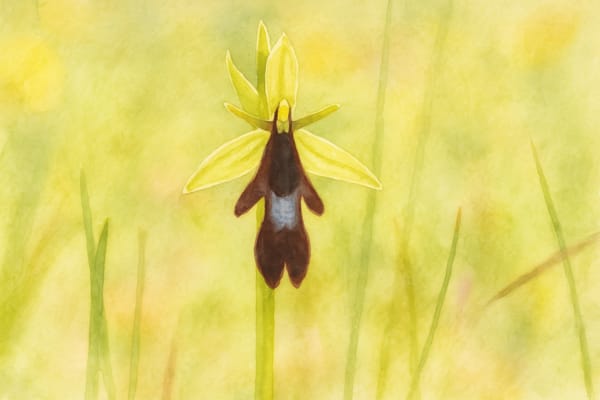Fly Orchid (Ophrys insectifera)
An elusive native orchid with insect-like flowers, the Fly orchid enchants with mimicry and mystery. A symbol of conservation in Cornwall, it thrives on chalky clifftops and in carefully managed grasslands.


An elusive native orchid with insect-like flowers, the Fly orchid enchants with mimicry and mystery. A symbol of conservation in Cornwall, it thrives on chalky clifftops and in carefully managed grasslands.


The Fly orchid is one of Britain’s most intriguing wildflowers—named for its remarkable mimicry of female digger wasps. Its slender green stem bears small, brown-purple flowers that visually and chemically imitate insects to lure pollinators. This evolutionary marvel has captivated naturalists since Victorian times.
Although it lacks the folkloric fame of other British plants, the Fly orchid’s elusive charm and rarity have given it quiet status as a symbol of conservation. Its presence is tied to ancient chalk grasslands and traditionally managed habitats—places now dwindling across the UK.
In Cornwall, it survives in fragments of unimproved grassland on calcareous soils—most notably on parts of the Lizard Peninsula and near inland chalk exposures.
Though difficult to cultivate without specialist conditions, it is possible to encourage Fly orchids in well-chosen coastal garden sites that mirror their native environment.
| Requirement | Details |
|---|---|
| Light | Full sun to partial shade |
| Soil | Well-drained, poor, chalky or sandy soils |
| Moisture | Moist but never waterlogged; tolerates drought once established |
| pH | Neutral to alkaline |
| Exposure | Tolerates wind and salt spray; ideal for coastal sites |
| Hardiness | Fully hardy in the UK |
Fly orchids thrive in the kind of exposed, dry, nutrient-poor soils found on coastal ledges and chalk cliffs. For naturalistic gardens focused on ecological restoration or wildflower diversity, they are a valuable—if delicate—addition. Best used in wildflower meadow zones where mowing or grazing is part of the routine.
| Step | Traditional Tip |
|---|---|
| Site & Soil | Calcareous or sandy, poor soil in sun or dappled shade |
| Sowing | In situ only; needs fungal partnership |
| Watering | Light moisture until established; then drought-tolerant |
| Maintenance | No fertiliser; mow/graze after seed; remove thatch and litter |
| Coastal Adaptation | Wind- and salt-tolerant; thrives on chalk cliffs, dunes, or rocky edges |